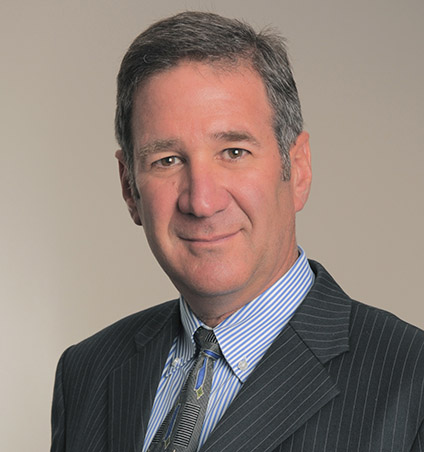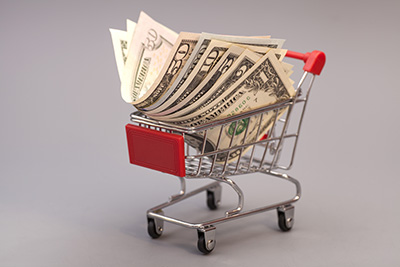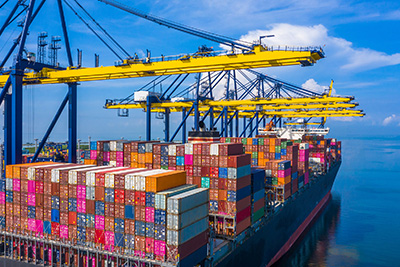Charting the Course
Clean-Up on Aisle Five! Will the Fed Cause a Recession to Curb Inflation?
By Mitch Siegler, Senior Managing Director

When little Johnny wanders off from his mom while grocery shopping and a half-dozen jars of spaghetti sauce come crashing down, stock-boys with mops and brooms are quickly dispatched. And when inflation threatens to crash economic growth and equity markets, Fed Chairman Jay Powell steps in to take the punchbowl away.
This month marks the second anniversary of the first pandemic shutdowns. With spring, we may be on the cusp of a new day with plummeting Covid cases and life returning to “normal.” We’re also seeing a more hawkish Fed, one prioritizing inflation – finally – over employment and economic growth. Well, it’s high time, with the recent news that January’s inflation rate, 7.5%, is the highest in 40 years. Futures markets are predicting five Fed Funds increases this year and the first interest rate boost will come this month.
We’ve been talking with our kitchen cabinet of CEO’s, portfolio managers, venture capitalists and private equity gurus to gauge how people are reading the tea leaves. We distill the collective wisdom and make sense of economic growth, employment, equity valuations, inflation, and interest rates below.
Brisk Economic Growth – Driven by Inventory Build, Consumers Spending Their Savings
Topline economic growth in 2021’s fourth quarter was a blistering 6.8%, nearly tripling from 2.3% in the third quarter, which was depressed by Covid’s Delta variant. (The Omicron variant surged in December and will impact growth in the first quarter.)
Growth isn’t nearly as rosy as it appears. The largest component of Gross Domestic Product (GDP) growth was a buildup in inventories, accounting for 4.8% (70%) of the growth. While much of this is a necessary restocking of store shelves to counteract supply chain issues, it’s a safe bet that this rate of inventory build-up is unsustainable, and growth will slow this year. (Rising interest rates restrain growth, and we make this call even before the first Fed increase.)
 Another big contributor to growth was consumer spending, which accounted for two percentage points of fourth quarter GDP. Much of that was driven by a spend-down of savings; the personal savings rate fell from 9.5% in the third quarter to 7.4% in the fourth. As government policies for putting more money in the pockets of consumers have waned, consumers will need to rely more on the sweat of their own brows and their savings in the months ahead. Perhaps that will bring some relief to employers who continue to struggle to find workers.
Another big contributor to growth was consumer spending, which accounted for two percentage points of fourth quarter GDP. Much of that was driven by a spend-down of savings; the personal savings rate fell from 9.5% in the third quarter to 7.4% in the fourth. As government policies for putting more money in the pockets of consumers have waned, consumers will need to rely more on the sweat of their own brows and their savings in the months ahead. Perhaps that will bring some relief to employers who continue to struggle to find workers.
Employment
The number of open positions continues to well exceed the number of officially unemployed as companies struggle to hire workers. The causes are diverse. There’s burnout, epitomized by those nearing retirement age to drop out of the workforce and Millennials who’ve rented Sprinter® vans to tour national parks rather than climb the corporate ladder. There were school closures and virtual school, prompting working parents to drop out of the workforce. There’s a dramatic slowdown in legal immigration (while the other kind has mushroomed). And there have been massive disincentives to work in the form of three $1,200-$1,400 Covid relief checks for hundreds of millions of Americans.
But, with the official unemployment rate at 4.0% in January (down from a pandemic peak of 14.8% in April 2020) and sizzling economic growth following pandemic shutdowns, it should be no surprise that prices for groceries, gas, homes, semiconductor chips and many other goods have been skyrocketing.
Loose Money in 2020-2021, Cracks in the Façade in 2022
Many attribute skyrocketing valuations for equities, real estate, fine art and other assets to extraordinary government stimulus in the U.S. and abroad. Since March 2020, U.S. fiscal stimulus has been extraordinary, with six trillion dollars in transfer-payments to state governments, businesses, and individuals and several trillion more in Federal Reserve monetary stimulus (purchases of Treasury securities). While not all these funds have made their way through the financial system – the $1.2 trillion infrastructure bill enacted in 2021 being an example – the majority of the 2020-2021 Covid relief funds were spent quickly.
This money was first used to backstop living expenses, then saved, since there were few places to travel or events to attend and shortages of so many goods. Many invested their extra cash, driving asset values higher. Last year set records for venture capital investment, SPAC’s and public technology company stock price performance. As in the dot-com era, the metric was not always profitability or even revenues but often intangibles like total addressable market and potential growth rates (remember the focus on ‘eyeballs’ in 1999-2000?) As in a game of musical chairs, asset values rise when more people are chasing a finite number of assets (chairs).
In the past few months, publicly traded technology stocks have been hammered, with many of the best performers in 2020 and early 2021 down 30-50%. As crossover investors – those who invest in late-stage venture capital rounds immediately before a public offering – marking down their public company investment portfolios, it’s inevitable that these same investors will soon take their medicine with markdowns on their private-company portfolios. That could translate into tougher times ahead for emerging companies seeking capital, lower valuations, and pressure on these companies to grow faster to satisfy more discriminating (read “less patient”) investors. Plenty of fine companies (which are already behind schedule and running short of cash “runway” because of delays from supply chain disruptions and labor shortages) won’t get the funding they need in what may be more of a “swing for the fences” financing environment. Look for ripple effects on economic growth in the next couple of years.
Surging Inflation – the Simmering Pot is Boiling Over
January’s 7.5% inflation is the highest since the Reagan administration. That contributed to plummeting real disposable income, which fell 5.8% after inflation in the fourth quarter, on the heels of a 4.3% decline in the third quarter. Consumer incomes and savings benefited greatly from government transfer payments in 2020 and early 2021 leading to a major sugar high for consumer spending as the economy reopened in the second half of 2021. Inflation fears have been dampening consumer confidence and consumers’ blood sugar levels appear to be crashing in 2022.
A late January NBC poll shined a spotlight on consumer agita. In response to a survey question “Do you think your family’s income is going up faster, staying about even with or falling behind the cost of living?”, only 7% reported that they were gaining ground while 31% felt they were breaking even and a whopping 61% said they were falling behind. If that’s not a wake-up call for politicians and policymakers, they need to seriously dial back their Ambien dosages.
Inflation Drivers – Supply Chain Disruptions and Labor Shortages
 For a year, the Fed and the Administration have explained away the sharp increase in inflation to pandemic-induced supply chain woes and labor shortages. Month after month, 100+ container ships remain anchored offshore near the ports of Long Beach and Los Angeles waiting to be unloaded; the vessel names change but the story remains the same. Manufacturers of consumer electronics, medical devices, autos and more have experienced production slowdowns attributable to a shortage of chips and other components. Producers respond with the lesser of two evils – they transport these parts via air freight, which keeps production lines operating but drives shipping costs through the roof.
For a year, the Fed and the Administration have explained away the sharp increase in inflation to pandemic-induced supply chain woes and labor shortages. Month after month, 100+ container ships remain anchored offshore near the ports of Long Beach and Los Angeles waiting to be unloaded; the vessel names change but the story remains the same. Manufacturers of consumer electronics, medical devices, autos and more have experienced production slowdowns attributable to a shortage of chips and other components. Producers respond with the lesser of two evils – they transport these parts via air freight, which keeps production lines operating but drives shipping costs through the roof.
But Covid-induced supply chain woes don’t tell the full tale. Many restaurants and hotels continue to scramble to recruit dishwashers, housekeeping staff and other entry-level positions. McDonald’s noted in its fourth quarter earnings release that it has reduced operating hours 10% system-wide because of staffing shortages. Quick-service restaurant operators, retailers and Amazon have all boosted wages by several dollars per hour over the past year. And they’re still struggling to fill open positions.
But it’s not just entry-level positions that are going unfilled. Hospital capacity during Omicron remained constrained not because of a shortage of beds but a shortage of nurses, technicians and cafeteria and janitorial staff. Friends who run software, communications, life sciences, FinTech and manufacturing businesses tell stories of being unable to hire people for six-figure positions. Even if early retirements have peaked, schools fully and consistently reopen (enabling parents of school-age kids to return to work) and government transfer-payments that enabled many to earn more watching Netflix than working are a thing of the past, labor-force participation rates are unlikely to return to pre-pandemic levels soon. And labor shortages raise prices.
The biggest inflation concern may be wage-price spirals – akin to a dance where both partners are trying to lead. Prices go up. Workers see rising prices for the goods they buy each day and demand wage increases so they can keep pace. Companies raise prices to compensate for higher labor costs. Consumers buy more than they need to avoid paying more in a few months, adding further pressure on limited supply. And the flywheel spins.
Inflation – Why it’s Such a Big Deal
 Bread, tea, wheat and onions. In history, rising prices for these basic foodstuffs have driven people to the streets to protest and have brought down empires. The rising cost of bread brought about the French Revolution. Higher taxes raised tea prices and helped precipitate the Colonial Revolution. Rising onion prices led to a change in India’s central government in 1980. High wheat prices contributed to the fall of the Soviet Union. In recent decades, more than a dozen Latin American governments, including Mexico and Argentina, have fallen following a surge in consumer prices. The Fed’s tone has now shifted, and Fed governors will be acutely aware of their need to combat inflation with full force – even though doing so will certainly slow the economy and may very well tip it into recession.
Bread, tea, wheat and onions. In history, rising prices for these basic foodstuffs have driven people to the streets to protest and have brought down empires. The rising cost of bread brought about the French Revolution. Higher taxes raised tea prices and helped precipitate the Colonial Revolution. Rising onion prices led to a change in India’s central government in 1980. High wheat prices contributed to the fall of the Soviet Union. In recent decades, more than a dozen Latin American governments, including Mexico and Argentina, have fallen following a surge in consumer prices. The Fed’s tone has now shifted, and Fed governors will be acutely aware of their need to combat inflation with full force – even though doing so will certainly slow the economy and may very well tip it into recession.
Interest Rate Increases: What We Can Expect This Year from the Fed
Last spring and summer, the Fed characterized inflation as “transitory” and common knowledge was that interest rates would remain “lower for longer” with no interest rate boosts until mid-2023. Now, futures markets predict five rate increases in 2022 – with a 100% likelihood of a March hike trending down to a 59% likelihood of a December increase. At the risk of stating the obvious, that’s an awfully big shift, pretty darn fast. And don’t be surprised if four or five 25 basis point rate hikes isn’t all we’ll get this year. The Fed has gone from being oh so patient to being downright panicky in a New York minute.
And increasing short-term interest rates aren’t the Fed’s only policy tool to slow the economy. The Fed has already begun shrinking its balance sheet by slowing its purchases of U.S. Treasury securities. At some point, bond sales could rise, accelerating the balance sheet effect. Reduced Fed demand for Treasuries will also contribute to higher longer-term interest rates.
What’s An Investor to Do?
Financial advisors are busy rebalancing portfolios, paring positions in speculative assets and boosting their ownership of higher-quality, blue-chips. Apart from the rare contrarian, most are rightly fearful of the impact rising interest rates will have on their clients’ bond portfolios and downshifting fixed income exposure accordingly. Venture capitalists are racing to pull term sheets and reprice deals. When the Fed takes the punchbowl away to cool inflation, the pendulum often swings too far, tipping the economy into recession. Long before, the stock market can get squeamish, and volatility can escalate.
In such an environment, we adore multifamily investments, a nearly perfect inflation hedge with rents resetting every year (or every month, in some cases). We love the Class-B, workforce housing sector, the value investor’s sweet spot since rents, 25-40% lower than Class-A properties, are so affordable. We continue to prioritize safety with low leverage on our properties and an emphasis on long-term, fixed-rate loans.
As the spring flowers bloom, it’s a time for optimism and we’re hopeful that plunging Covid case rates mean that life is returning to normal. We see lots of economic tailwinds out there but no shortage of headwinds. Buckle up.
Mitch Siegler is Senior Managing Director of Pathfinder Partners. Prior to co-founding Pathfinder in 2006, Mitch founded and served as CEO of several companies and was a partner with an investment banking and venture capital firm. He can be reached at msiegler@pathfinderfunds.com.
Share this Article
